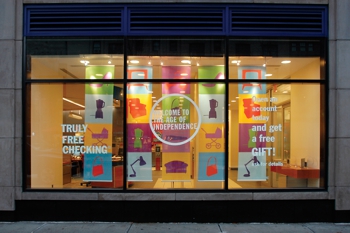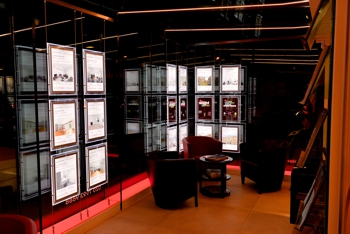Fairfield displays - Not all fixtures are the same

Janice Fairfield, Marketing Director of Fairfield Displays & Lighting, notes that there are numerous types of fittings available, ranging in the number of parts, materials and finishes. All sign fixings are not the same – which can be made apparent if used in a single installation.
“I have frequently seen buildings with a real mismatch of fittings from different suppliers, and the co-ordination of the scheme has been completely spoilt,” says Janice. “The way a sign is fixed to the wall can make a tremendous difference to the visual appearance and the perceived value of the sign. Sign makers are always looking at ways to increase profit, and simply using a professional looking sign fixing can make a huge difference.”
Fixings may appear to be just a perfunctory part of sign installation, but opting for the right part for the job at hand can make a significant difference to not only the finished look, but also ease of installation. Fixings can be made in two parts or three parts, with three-part fixings offering many benefits to sign makers. “One huge advantage is that they are so much easier to fix,” says Janice. “The back section is a brass boss, which is quick and easy to screw to the wall. It will take up to a no.10 screw, which means you can get a good fixing in a brick or breeze block wall.” As the fixing can be implemented without using a screwdriver, it’s a useful choice when working on ladders and is a quick and easy option for most signage jobs. When working with wooden display panels or doors, small, two-part fixings are ideal. “The hole size will vary from supplier to supplier, but they normally start from around a no.6 to a no. 8 screw size,” says Janice.

Suspended cable vs. standoff fixings
The two types of primary fixings are standoff, which holds a sign away from a wall, and suspended cable, which can hang signs from numerous different surfaces. These two primary fixings can help create very different finished effects, and can be used in a number of different settings.
A standoff fixing holds a sign away from a wall, and can be used indoors to create signage in places like reception areas, and outdoors to promote things like menus. Small and large signs can easily be fitted with standoffs, and are supplied from 12mm diameter up to 25mm diameter, and in depths from 14mm up to 75mm.
Standoffs are versatile and easy to use, and can be used in conjunction with a single sign or mounted on a wall in a group to create directory signage. “Standoffs are used when you need a fixed position sign which can be mounted to a flat wall, desk or display unit,” says Janice. “One advantage of using this type of fixing is that it is easy to change a sign at a later date. Another is the overall appearance; as the sign is away from the wall, dust will drop down behind which means it will always remain smart and clean. Standoffs are a great way to turn an ordinary wall mounted sign into something that looks absolutely stunning compared to an ordinary screw, which gets rusty.”
Suspended cable systems (also referred to as rod systems) are a great choice when it comes to fixing multiple signs, giving the end user more control and flexibility.
A suspended cable doesn’t need to be fixed to a flat wall, and can be hung instead from a number of surfaces. This system works well for a multi-sign project, as well as in cases where the sign may need to be changed frequently. Removing and replacing a fixed sign is time-consuming, and can leave behind holes and other structural damage in the process. A suspended sign, however, can be simply swapped in and out while being hung at any height on the vertical cables or rods. “In cases where information is constantly changing, opt for an acrylic pocket, and then signs and graphics can be dropped in without the need to use any tools. The cheaper it is to change the sign, the more opportunities there are for repeat business,” affirms Janice.
Quality is key
As with most signage components, cheaply made fittings are likely to break sooner, and those that don’t will age and make the overall signage look old and untidy over time.
“Cheap fittings tend to be made from aluminium, while quality fittings are made from solid brass and are finished in an elegant satin chrome or high gloss polished chrome,” says Janice. “While aluminum standoffs or cables may look similar, they will have a much shorter life span and are not suitable for use in a moist environment, as the dampness can affect the threads. Something as simple as damp umbrellas being stored in reception could affect the them, which is why if these fittings come with guarantee at all, it’s only usually for one year.” Brass fittings, on the other hand, have quality smooth threads that come with a lifetime guarantee, and are easy to replace to keep signage looking fresh and polished for years.
At Fairfield, Janice is noticing that clients are demanding more from even simple signage and display units. “Lighting is becoming more and more integrated even in very basic signage – it’s now extremely easy to add a touch of sparkle by using LEDs.” These lights can be used behind panels mounted with standoffs to add an attractive glow, or alternatively sign makers can clip LED Light Pockets™ to a cable or rod system to create an illuminated sign at any height, without any complicated wiring.
To learn more, visit www.fairfielddisplays.com.
